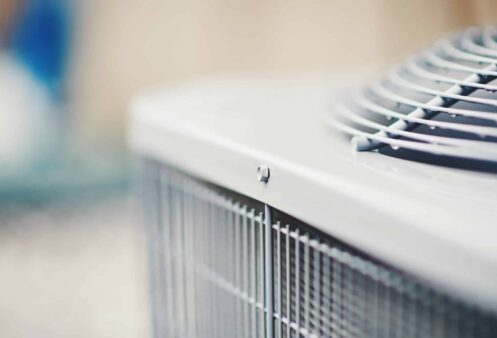Today, a growing number of homeowners are considering heat pumps as a replacement for their conventional HVAC systems. The reason for this is that heat pumps claim to offer massive efficiency gains. They tend to offer cheaper operation than the systems they replace. However, not many people understand how heat pumps manage to achieve their claimed efficiency. After all, they don’t look much different than conventional HVAC systems to the untrained eye. So, here is a detailed explanation of how heat pumps achieve amazing efficiency.
Understanding CoP, SEER, AFUE, and HSPF
Before you can understand how heat pumps work so efficiently, you’ll need to understand a few commonly used efficiency measurement terms. The first is Coefficient of Performance (CoP). It’s an efficiency measurement you’ll often see associated with heat pumps. Essentially, a CoP rating tells you the ratio of how much useful heat or cooling a heat pump produces per watt of energy consumed. Therefore, the higher the CoP, the more efficient the heating system.
These days, it’s possible to find air source heat pumps with a CoP as high as 4. That means they’ll produce four units of heat for every watt of power they use. By comparison, an electric-resistance heating system has a CoP of 1. And even the most efficient gas-powered furnaces have a CoP of around .93.
However, you won’t find CoP ratings on most conventional HVAC systems. Instead, most furnaces have an AFUE rating. The good news is that AFUE and CoP are similar enough to be almost interchangeable. The difference is the terminology. AFUE offers an efficiency rating as a percentage. So, when you see a furnace with an AFUE of 85, it means it creates usable heat from 85% of the fuel consumed. The remaining 15% gets wasted. An AFUE of 100 is the equivalent of a CoP of 1. However, no conventional furnace has ever gotten an AFUE rating that high.
The next efficiency measure you’ll see is often found in air conditioning systems known as SEER or Seasonal Energy Efficiency Ratio. It’s a number that’s supposed to convey how energy-efficient an air conditioner will be when you use it over an entire average cooling season. The major difference between a SEER rating and CoP is that the former simulates real-world use to arrive at its rating. To convert a SEER rating into a CoP value, you only must multiply it by .293. The same thing is true for HSPF or Heating Seasonal Performance Factor ratings. They’re like a SEER rating, except for heating systems. So, you can convert them into CoP ratings the same way.
The Difference Between a Heat Pump and Conventional HVAC
With the major terminology out of the way, it’s time to understand what makes heat pumps different from other kinds of HVAC systems. The simplest way to explain the difference is that heat pumps don’t produce heat. Instead, they move it from one place to another.
That’s a fundamental difference between heat pumps and furnaces. A furnace burns natural gas to produce the heat you need for your home. As a result, the highest CoP a furnace could ever achieve is 1. That would mean that the furnace converted 100% of the fuel into usable heat.
However, a heat pump doesn’t consume electricity to create heat. Instead, it uses it to power a compressor system that manipulates the pressure of a refrigerant. It does so to capture heat energy from the outside air, so it can carry it inside to heat your home. That’s why a heat pump can have a CoP higher than 1. It’s because a heat pump isn’t exchanging electricity for heat. So, the better it does at capturing available heat in the air, the more efficient the system is.
If you’re thinking that a heat pump sounds an awful lot like an air conditioner operating in reverse, you’re right. Air conditioners work in much the same way, except that they capture the heat inside your home and carry it outside, thus cooling off the interior of your home. This is also why you’ll find SEER ratings on air conditioners that reflect CoP ratings like those of heat pumps.
What About When It’s Cold Outside?
Here in the Gilbert, AZ, area, we don’t get too many very cold days each year. However, it’s natural to question how a heat pump would perform in the cold. After all, how can a heat pump extract heat from the air when it feels like there’s none to find?
The thing is humans are terrible at judging heat and cold. To us, a temperature close to freezing feels like just that—freezing. However, there’s always heat energy in the air for a heat pump to capture, except when the air temperature reaches absolute zero. Since that would be the equivalent of a -459.67-degree Fahrenheit day, that’s not something any of us will ever experience.
Heat pumps, however, do begin to lose efficiency when the air temperature outside drops below 40 degrees Fahrenheit. However, most heat pumps remain more efficient than today’s furnaces down to about 25 degrees Fahrenheit. The good news is that the climate here in the Gilbert, AZ, area makes that a non-issue for homeowners.
On the off chance that we get a cold snap, though, a heat pump will still heat your home effectively. That’s because they come equipped with an auxiliary heat source that uses electric resistance heating to augment your home’s heat supply. And although running in that mode isn’t very efficient, it’d have to happen daily to make heat pumps a worse option than a conventional furnace.
Are Heat Pumps More Efficient Than Conventional Air Conditioning?
Since they use similar principles to operate, heat pumps and conventional air conditioners often boast similar efficiency levels. However, many of today’s heat pump systems include variable-speed compressors and fans that help them be among the most efficient air conditioning options available.
That’s especially true of ductless mini-split heat pumps. Since they do away with energy losses associated with running cold air through leaky ducts, they’re often far more efficient than conventional air conditioners. And since a mini-split allows you to cool only the parts of your home you’re using, they allow you to make the absolute most of their efficiency all summer long.
We’re the Heat Pump Experts
Now that you know how heat pumps achieve their amazing efficiency, perhaps you’d like to learn even more about them. Or, maybe you’re interested in how a heat pump could help you to heat and cool your Gilbert, AZ, home more efficiently. If so, you’ll want to call the experts here at A/C & Plumbing Doctors. We’re a family-owned and operated business with over 20 years of experience in the HVAC industry. We offer comprehensive HVAC services, including the repair and maintenance of all types of HVAC systems. We also offer indoor air quality services, and work on commercial HVAC systems, too!
So, if you’re ready to make a heat pump a part of your home’s comfort systems, contact A/C & Plumbing Doctors today, and we’ll be happy to help.





